2025 New Year’s Resolution: Be an advocate!
As we reflect back on our exceptional work to increase voter turnout during the November 2024 elections, you may be wondering how to carry this momentum into the new year. One way you can keep making an impact is to add “Be an advocate!” to your list of New Year’s resolutions.
If you want to get a head start, identify one issue that you are passionate about and use that as the basis for your weekly Advocate Action!
The League of Women Voters Kansas has selected these legislative priorities for the 2025 session of the Kansas Legislature:
- Voting Rights
- Reproductive Rights
- KanCare Expansion
- Climate Change
- Criminal and Youth Justice
- Water
- Government Transparency
Other issues we expect to be heavily discussed in the upcoming session are:
- Tax Policy
- Education Funding
First Step: Advocate Action: Find your Kansas Senator and Legislator!
Step 1: Open this website: https://pluralpolicy.com/find-your-legislator/
(Note: Alternatively, you can go to https://kslegislature.org/, click on “Find Your Legislator”, and click “Search by Your Address”, but this route will take you to the same website linked above.)
Step 2: Enter your address
Step 3: Click "Search”
Step 4: View your state representative and senator on the Plural Policy website or return to kslegislature.org to view their contact information, committees, and any bills and resolutions they have sponsored.
Step 5: Now that you know who is representing you in Topeka, add their phone number and email address to your contact list so you can quickly reach out to them throughout the legislative session.
Second Step: Advocate Action: Contact your State Senator and Representative
This week, reach out to both your Senator and Representative! Using the contact information you found last week, you can call them or send an email. Introduce yourself as a constituent and let them know your priorities for this legislative session.
Tip 1: Use the proper title and last name.
When addressing a senator in writing, the proper salutation is "Dear Senator [Last Name]".
You can also use the following salutations:
- The Honorable [Last Name]
- Senator [Last Name]
- Senator [First Name] [Last Name]
When addressing a House Representative in writing, the proper salutation is "Dear Representative [Last Name]".
You can also use the following salutations:
- The Honorable [Last Name]
- Representative [Last Name]
- Representative [First Name] [Last Name]
If you are writing to either a senator or representative about a specific piece of legislation, you can also address them by their title as chairman or chairwoman of the committee that is considering the legislation.
Tip 2: Be clear and concise in your message.
- Focus on one issue per message. If you have multiple requests you can send multiple communications.
- Suggest specific actions you would like them to take: introduce a bill, hold a committee hearing for a bill, vote for or against a bill, sustain or override a veto, etc.
- Be specific and factual. Use examples, statistics, or personal anecdotes to illustrate your point.
Tip 3: Maintain a respectful and professional tone.
- Avoid negativity and personal attacks. Focus on the issue, not the person.
- Proofread carefully. Typos and grammatical errors can undermine your message.
- Show appreciation (if applicable). Acknowledge their past efforts or positive stance on related issues.
Bonus Tip: Copy additional elected officials as appropriate.
- Consider adding leadership (House Leadership and Senate Leadership) so they know what Kansans across the state want.
- If you are reaching out to a committee, copy your senator or representative so they know your stance.
- If you are reaching out to someone with a different viewpoint than yours, copy an elected official that shares your view.
Advocate Action: Learn How a Bill Becomes a Law
This week, we will be learning (or reviewing) how a bill becomes a law in Kansas. The Kansas Legislature created this outline of the process:

Source: How a Bill Becomes Law-Kansas
One step to highlight is: “Bill Referred to Committee.” In the House, the Speaker refers bills and resolutions to the appropriate committees. In the Senate, the President refers bills to committees. The elected majority party sets the legislative agenda, but either the Speaker of the House or the Senate President could single-handedly stop all progress on legislation! To illustrate, this happened in 2020, when then President Susan Wagle “sent more than a dozen bills that could be used as legislative vehicles for Medicaid expansion back to committee, ensuring they won’t be passed anytime soon” after a separate vote failed in the House. (source: As Kansas lawmakers battle over abortion, Medicaid expansion could be casualty)
If you aren’t seeing progress on a bill you support, you can contact leadership to request that the bill is referred to a committee. Here are a few more people to add to your contact lists:
Representative Daniel Hawkins - Speaker of the House
Phone: 785-296-2302
Email: dan.hawkins@house.ks.gov
Senator Ty Masterson - President of the Senate
Phone: 785-296-2419
Email: Ty.Masterson@senate.ks.gov
Advocate Action: Attend A Legislative Coffee
One of the best ways to stay informed of what has happened and what is upcoming in the Kansas Legislature is to hear it directly from your elected senators and representatives. The League’s Voter Information team makes this easier than ever by partnering with local libraries to host several Legislative Coffees throughout the session. You can attend in person or watch the live stream on YouTube. All Legislative Coffees are on Saturday mornings from 10:00-11:00 am. Check the LWV JoCo calendar for the most up to date information.
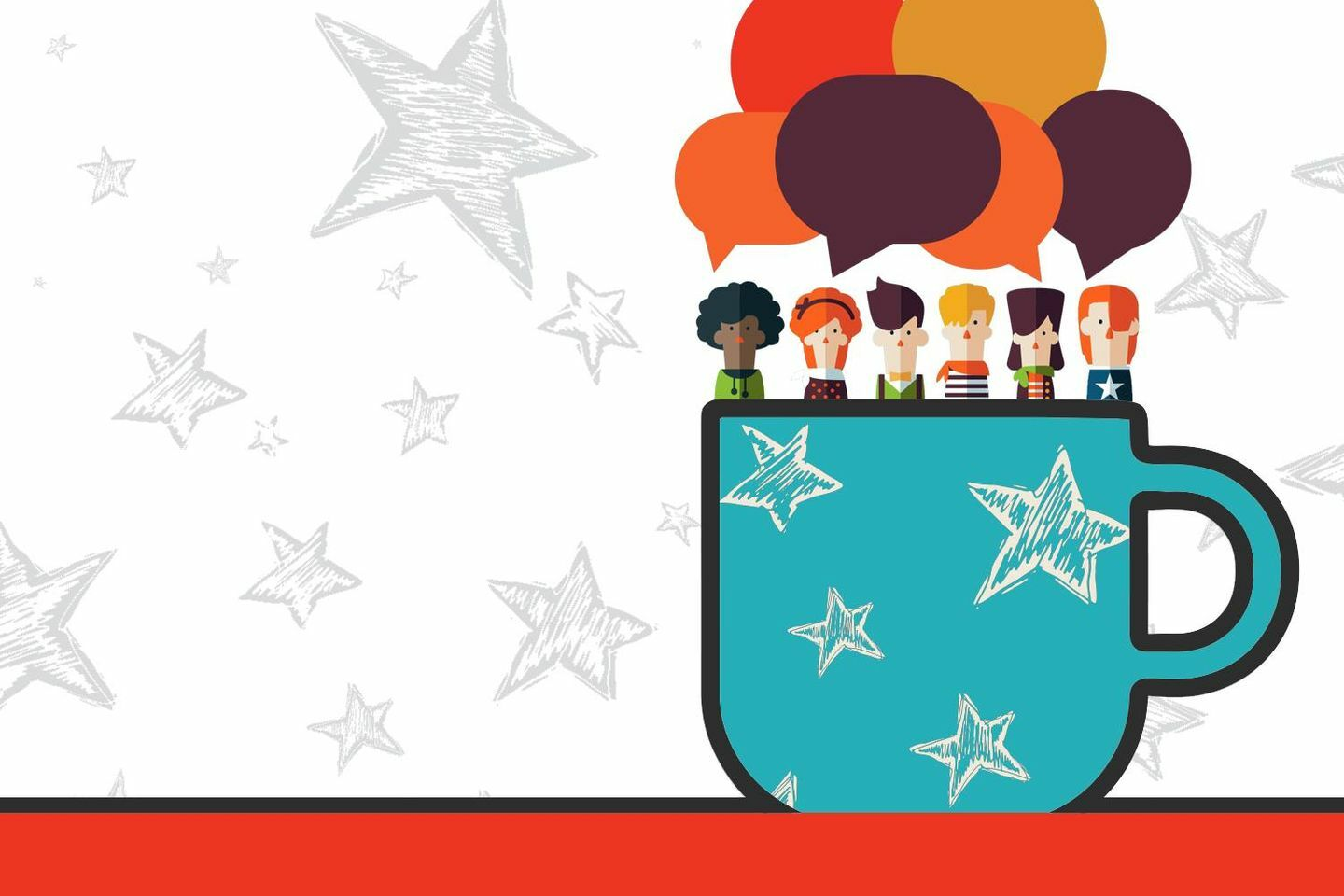
Advocate Action: Look up a Bill
If you know what bill you are looking for, you can type the bill number directly into the “Find a Bill” section on the left side of kslegislature.org and then click “Lookup.”
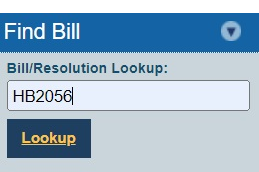
If you don’t know the bill number, you can search for keywords in the upper left hand corner:

Once you are on viewing a specific bill, you can find information including:
- Short Title
- Testimony and Minutes
- Current Sponsor
- Original Sponsor
- Requested for introduction by
- Bill Versions
- Documents is the actual text of the bill
- SN (Supplemental Note) is prepared by the Legislative Research Department and contains information like a plain language summary of the legislation, background information, and fiscal information.
- FN (Fiscal Note) which estimates how much a bill would cost.
- Bill History
Not all bills have all of this information. For example, Supplemental Notes and Fiscal Notes take time to create so they are not on every bill introduced. If a bill never gets a hearing, there won’t be any testimony.
Practice Example 1: Here is a bill introduced in 2023 showing all of the information listed above. Can you find HB 2056 on kslegislature.org and locate/view the opponent testimony submitted by the League of Women Voters of Kansas?

Practice Example 2: Lookup HB2284 on kslegislature.org. Read the supplemental note from when the bill was originally introduced. Then read the short title of the bill and the Conference Committee Report Brief. Do these sound like the same bill?
This is an example of the controversial practice known as “Gut and Go” where the original contents of a bill are removed and replaced with a different bill. By using the shell of a bill that was already at the Conference Committee step in the legislative process, Republican leadership was able to bypass committee hearings and eliminated the opportunity for expert and public testimony in their push for a flat tax. Republicans aren’t the only party to use this practice. In 2019, Democrats in the Kansas House used “Gut and Go” to pass Medicaid Expansion.
Advocate Action: Request Committee Agendas
Legislative committees provide a forum for in-depth analysis of proposed legislation, allowing for expert opinions and public input to be considered before bills reach the committee of the whole for debate and voting.
There are different types of committees such as standing committees, select (special) committees, joint committees, statutory committees, subcommittees, and task forces. This month we are focused on standing committees.
Most standing committees are created for the purpose of considering proposed legislation and reporting recommendations thereon. Standing committees normally meet at a regular time and place each day, although the actual number of meetings held is determined largely by the magnitude of the workload. Weekly committee agendas are prepared and are printed in the calendar and online in advance of the meetings. These agendas also are distributed to members, legislative staff, the media, and the general public. The week’s advocate action is to reach out to the committee(s) in the House and Senate that relate to your top issue(s) and request to receive committee agendas.
Here’s how:
- Find the committee in the list below and click the hyperlink or find their Committee page on the Kansas Legislature website.
- At the top of the page you will see the name of the committee assistant and an email address.

3. Send an email that can be as simple as: “Can I please be added to the recipient list for committee agendas?”
4. Receive weekly agendas (and updates) and find out what bills have upcoming hearings.
The standing committees in the Senate are:
The standing committees in the House are:
Advocate Action: Email Committee Members
Last week you were introduced to committees and next week we will go deep and learn about submitting formal testimony. This week we will focus on less formal, but still incredibly important emails to committee members.
Emails are useful in a few scenarios:
- A committee hasn’t scheduled a hearing on a topic, so it is not possible to submit testimony. In this scenario, you would request a hearing so that it is possible to submit testimony.
- A committee has already had a hearing or scheduled an upcoming hearing on a specific bill. In this scenario, the bill could come up for a vote after the hearing and you would request that committee members vote for or against it.
Here’s how:
Find the committee page on the Kansas Legislature website to view it’s members.
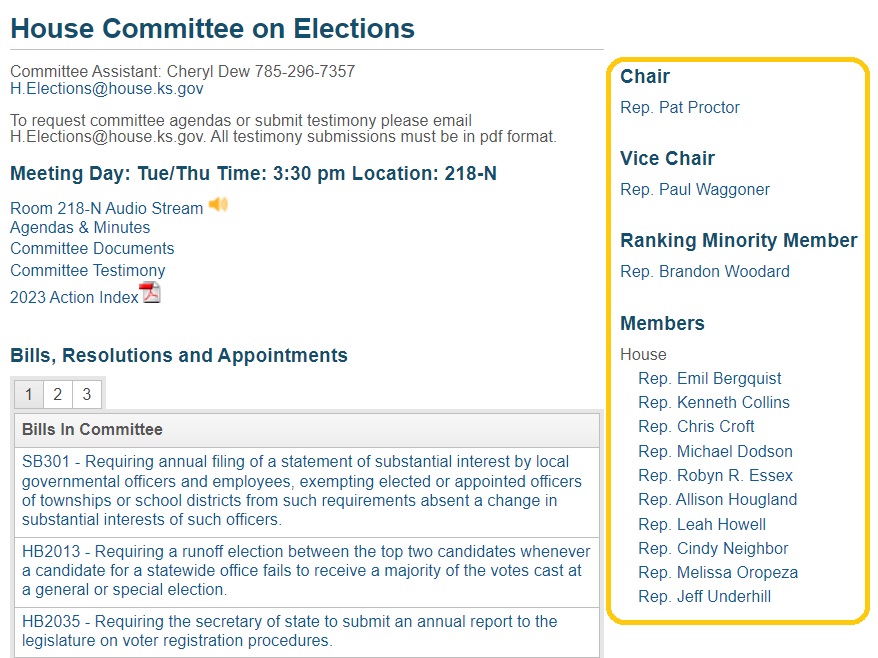
You could click on the hyperlink of every member to find their email address under their contact information. Alternatively, if you want to save time, scroll to the very bottom of the page, export the members in a spreadsheet, and quickly copy/paste all of their email addresses into your recipient list.
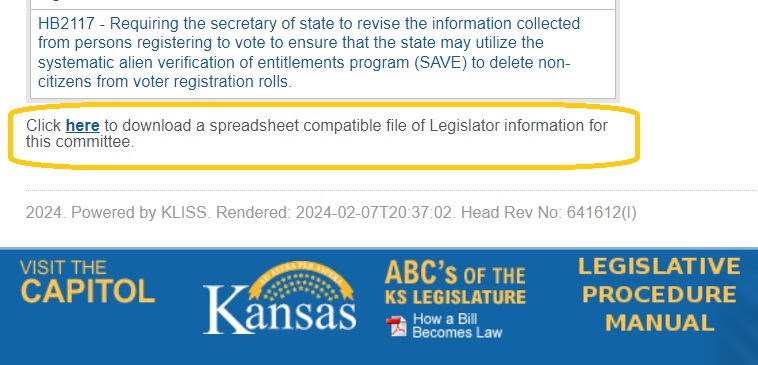
Write your email following the same tips from our January 9th Advocate action:
- Use the proper salutation
- Be clear and concise
- Maintain a respectful and professional tone.
Advocate Action: Submit Testimony
What is testimony?
Testimony is a formal statement made by an individual or organization before a legislative committee during a hearing on a proposed bill or resolution. The goal of testimony is to inform the committee members about the potential impacts of the proposed legislation and influence their decision on whether or not to move the bill forward.
Why is testimony important?
The first opportunity to support or stop a bill is in committee. The more testimony received, the better the chances of getting good bills out of committee or stopping bad bills from moving out of committee.
If a bill does reach the floor, legislators who aren’t members of the original committee can see how much support or opposition there was for a bill and can also review the testimony submitted.
How do I submit testimony?
-
Research the committee’s requirements.
-
Write your testimony.
-
Submit your testimony.
-
Email your written testimony to the committee assistant before the deadline. If paper copies are required, find an ally in Topeka to help deliver them.
-
If you also plan on giving oral testimony, in person or remotely, be available for the entire committee meeting and wait until your name is called.
Here is an example of where to find testimony requirements for the House Committee on Elections. First, click on Committee Documents: 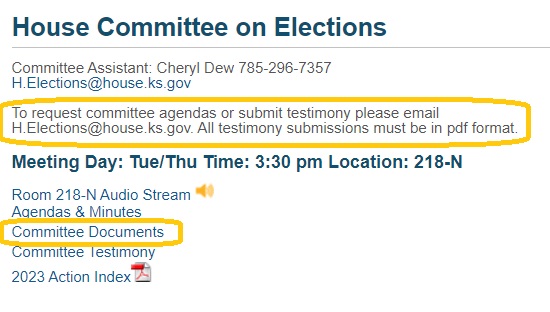
Then, review the committee rules for conferees and notice that this committee has a cover sheet for testimony:
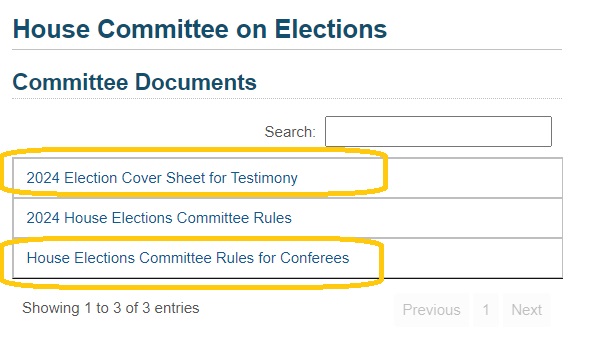
Advocate Action: Watch a Committee Meeting or Chamber Proceedings
Take some time this week to watch a committee meeting, house chamber proceedings, or senate chamber proceedings.
Here’s how:
On the Kansas Legislature website, click the Audio/Video dropdown. You can use either of the two bottom links.

The Statehouse Live & Archive option takes you to this view. You can view all past and future videos for a specific date on the Calendar - Day/Month view (seen below). Now Playing will show you active live streams or upcoming events. New Recordings will show you past events.

The House, Senate & Committee Video option takes you to this Kansas Legislature YouTube page. You can view current and upcoming live streams. There is also a playlist for house chamber proceedings, senate chamber proceedings, and every committee so you can view videos in chronological order or find a specific date.
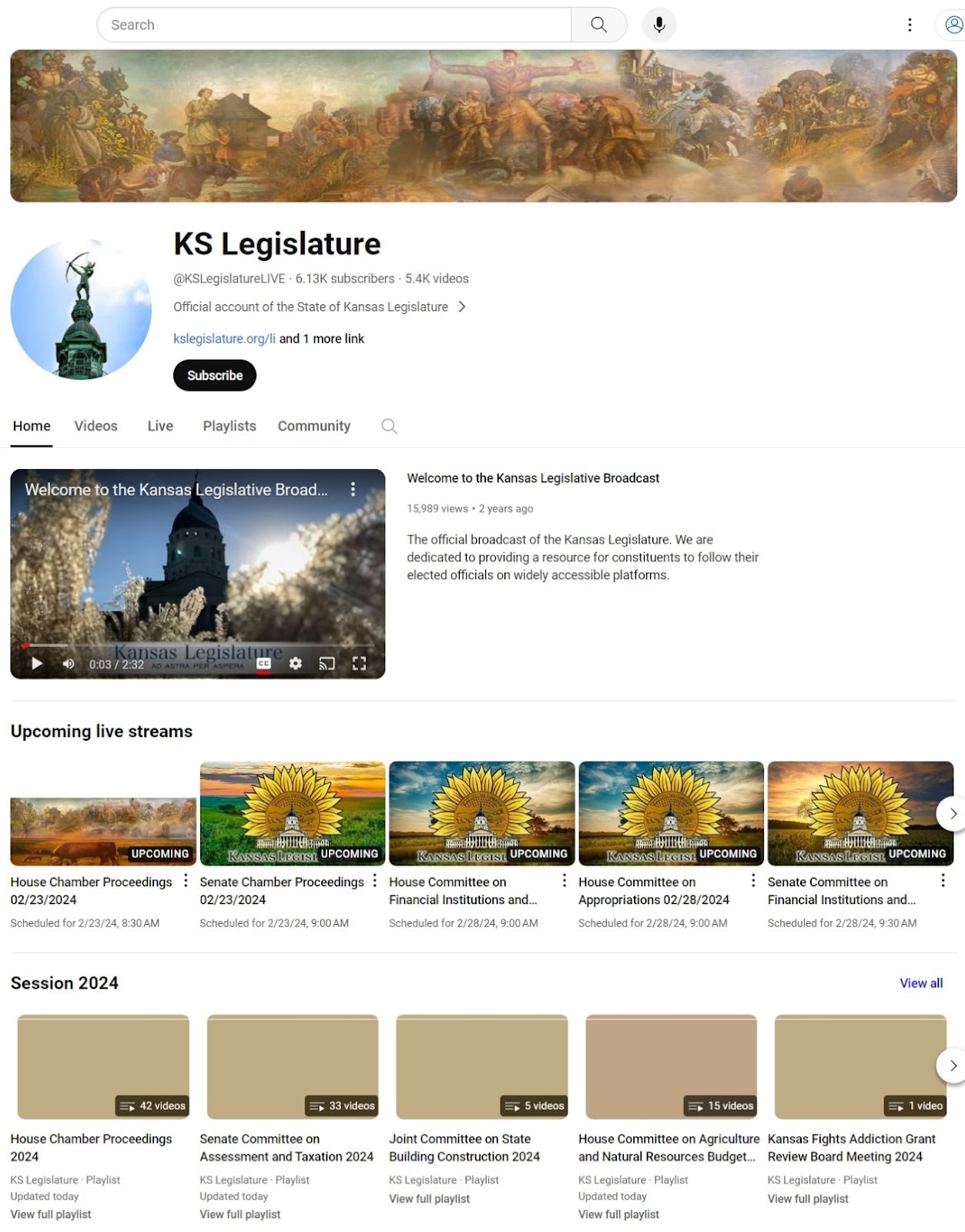
Advocate Action: Find a Like Minded Organization
Our League strives to be a comprehensive information and advocacy resource. However, as a volunteer-based organization, our capacity to track the rapid pace of the Kansas legislature, which can also lack transparency at times, is limited. This is where combined efforts become essential! Numerous organizations that share our legislative priorities work tirelessly across the state every day. By connecting with these organizations, in addition to our League, you can learn more about specific issues and additional advocacy opportunities.
Your Advocate Action this week is to find an organization that is working on your most important issue(s) and sign up to receive their updates and/or action alerts.
Advocate Action: Ask a Friend to Advocate!
This week’s Advocate Action is to ask a friend, or several friends, to advocate with you.
Why to make the ask:
There are many reasons to ask your friends to advocate alongside you for the issues you care about. Here are a few:
-
Strength in numbers: A single voice can easily get lost in the crowd. By advocating together, you amplify your message and show broader public support for the cause.
-
Diversity of perspectives: Your friends might have different experiences or approaches to an issue, which can strengthen your overall message and present a more well-rounded argument for the cause.
-
Personal connection: People are often more receptive to messages from friends and family. Your friends can reach people you might not be able to.
-
Building community: Advocacy can be tiring. Sharing the work with friends makes it more manageable and more enjoyable. Working together on an issue can foster a stronger sense of connection with others who share your values.
How to approach the ask:
-
Find common ground: Does this issue connect to something your friends already care about deeply? Focus on the aspects of the cause that resonate with your friends. Highlighting the personal connection can spark their interest in taking action.
-
Focus on positive change: Frame the advocacy as a way to create a better future for everyone, not just negativity towards an issue.
-
Offer clear, manageable actions: Don't overwhelm your friends. Suggest specific ways they can advocate, like:
-
Respect their comfort level: Not everyone is comfortable with all forms of advocacy. Offer a range of options so they can participate in a way that feels right for them.
-
Provide resources and talking points: Make it easy for your friends to participate. Offer links to credible sources, pre-written emails (and encourage personalization), or sample talking points.
-
Be respectful of differing views: Not everyone will agree with your stance on an issue. Be prepared to have a civil conversation and focus on common ground if possible.
-
Celebrate progress: Thank your friends for their participation, no matter how big or small. Report back on any victories or positive developments to keep them engaged.
Advocate Action: Submit a Letter to the Editor or Opinion Piece
If you have been following along with our Advocate Actions this legislative session, you have reached out to your elected officials, legislative committees, and your friends. If you are ready to reach a wider audience, consider submitting a letter to the editor or opinion piece.
Here's how you can prepare a strong letter to the editor (LTE) or opinion piece (op-ed):
Before you write:
-
Check publication guidelines: Most publications have specific requirements for submissions, including word count, format, and contact information. Look for these on their website or in the print edition.
-
Pick your topic: For an LTE, tie your response to a recent article or issue discussed in the publication. For an op-ed, choose a current issue you feel passionately about.
-
Research & develop your argument: Gather facts, statistics, or personal anecdotes to support your claims.
Writing your piece:
-
Craft a strong opening: Grab the reader's attention with a thought-provoking statement, anecdote, or question.
-
State your position clearly: Briefly introduce the issue and your stance on it in the first paragraph.
-
Develop your argument: Use clear and concise language to explain your reasoning. Facts, statistics, and personal stories can strengthen your position.
-
Consider the opposing viewpoint: Briefly acknowledge other perspectives and explain why yours is stronger.
-
Call to action: End with a clear statement about what you want readers to think or do after reading your piece.
Tips for both LTEs and op-eds:
-
Keep it concise: Aim for 150-200 words for LTEs and 400-800 words for op-eds (depending on publication guidelines).
-
Maintain a respectful tone: Even if you disagree with something, avoid personal attacks or inflammatory language.
-
Proofread carefully: Ensure your writing is free of grammatical errors and typos.
By following these steps and considering the differences between the two formats, you can craft a compelling letter to the editor or opinion piece that gets your message across and sparks conversation.
Learn more:
Check out a past event with LWVJoCo and Derek Donovan, community engagement editor of the Kansas City Star, to learn how to effectively express your view on a current issue of importance to you. Donovan will share what he looks for in a letter to the editor and answer your questions.
Letter to the Editor: Making Your Voice Heard
Here are some submission guidelines for local news outlets:
Kansas City Star (accepts Letters to the Editor):
https://www.kansascity.com/opinion/letters-to-the-editor/submit-a-letter/
Kansas Reflector (accepts Opinion pieces):
https://kansasreflector.com/submit-opinion/
Advocate Action: Learn about the Veto Process and Contact Governor Kelly
This is the last week of the regular legislative session which means it is the final opportunity for legislative action on most bills. If a bill is passed by both the House and the Senate, it is sent to the Governor.

The Governor has ten days after receipt of the bill to act on it - either signing the bill into law or vetoing the bill. If the Governor does not act on it during the ten-day period, the bill automatically becomes law.
In appropriation bills only, the Governor may veto some items and approve the others by signing the bill. This is known as a line-item veto. A line-item veto allows the Governor to target specific spending they disagree with without vetoing the entire bill and potentially shutting down essential government functions.
This Week’s Action: If you disagree with a bill that has passed both chambers or an item in the budget, contact Governor Kelly and request a veto. Phone numbers and a contact form can be found on her website: https://governor.kansas.gov/contact/
The Legislature may pass a bill over the Governor’s veto by a two-thirds vote of each of the houses. Veto overrides will be the subject of our final Advocate Action in a few weeks.